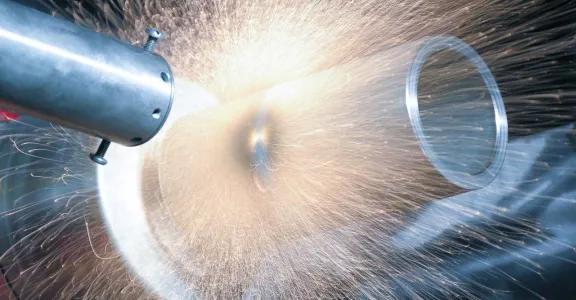Cold spray is an innovative technology in which metallic or ceramic powder particles are sprayed onto a surface at high speed. The particles then form a coating or 3D structure (a form of additive manufacturing). Due to the combination of low temperature and high speed of the powders, this is a purely kinetic process with a number of important advantages.
Advantages of the cold spray technology
- The material does not melt.
- Pore-free coatings.
- Fast layering.
- Minimal heat input.
(Multi)-material applications by variation of powder combinations and layer buildup.
How does cold spray technology work?
Various types of the technology exist:
Low-pressure cold spray
- Suitable for ductile metals and alloys like aluminium, zinc, copper, nickel and tin.
- Mobile and manually operated.
- Ideal for local repairs of complex or difficult to move parts.
Medium-pressure cold spray
- Extends the possibilities of the low-pressure device to Inconel 625 and titanium.
- Mobile and manually operated.
- Ideal for local repairs of complex or difficult to move parts.
High-pressure cold spray
- Suitable for the widest range of metals and metal-ceramics, such as stainless steel, Invar and chromium.
- Robot-controlled deposition, so that 3D printing is possible.
- Not mobile of manually operated.
- Usable only in a closed space with robot-controlled systems.
Determination of the exact deposition parameters (recipes) and powder compositions is crucial to achieve a good result. When the parameters are not correct, the adhesion/density is not optimal, or a blasting treatment is carried out instead of deposition of a coating. The part or coating can be finished to the right dimension and surface roughness.
Coating properties of the cold spray technology
The cold spray technology, with limited heating of the substrate, makes it possible to apply coatings with:
- Minimal porosity and good mechanical adhesion.
- Virtually no stresses in the material, so that a heat treatment afterward is unnecessary.
- Retention of the powder properties, because the metal powder does not melt and no oxides are formed .
- Possibility of applying conducting pathways and structures on a part at high speed.
- Multi-materials or coatings on various substrates.
Applications and sectors
Cold spray technology is already being successfully used in a number of sectors, including aerospace and defence, but also offers opportunities in the automobile industry, oil and gas sector, offshore, shipping, electronics, foundries and manufacturing.
Examples are:
- Assembly, repair or redesign of various components such as heat exchangers, castings, busbars, parts subject to wear (gears, rollers, drums), medical components, conducting parts, sliding bearings and metal structures.
- Application of electrically or thermally highly conducting layers or structures on parts.
- Creation of multi-material components and functional coatings (wear-resistant, corrosion-resistant, low-friction, induction).
- Repair of simple of complex parts (pitting corrosion, leakage, etc.).
- Repair of difficult to move components.
- Remanufacturing of existing parts in redesign of a product or machine.
- (Periodic) repairs of wear.
Cold spray technology: economic and ecological impact
Cold spray technology offers both economic and ecological advantages.
Repairing or modifying products and parts onsite and directly on the product significantly extends the lifespan of products and parts. This reduces the need for new parts, diminishes materials consumption and reduces waste, which results in significant cost savings.
In addition, the coatings are stable and have no damaging effects on the environment. The process is more environmentally friendly (lower CO2 impact) than welding, thermal spraying or PVD/CVD.
These properties make the technology highly suited for (local) repair within the circular economy and reinforcement of (expensive) metal and temperature-sensitive parts. The investment costs for low- and medium-pressure devices are reasonable, and the operating costs are acceptable. Consequently this deposition technology is economically sound and competitive with existing high-temperature technologies.
Why is Sirris investing in cold spray technology?
The maturity of this technology is currently TRL4-TRL7, at which the added value has already been demonstrated for a limited number of materials and applications in aerospace, defence and manufacturing. Sirris is convinced that the possibilities go much farther, for small and medium-sized businesses as well. The technology is however still relatively unknown, and the parameter study can be a time-consuming challenge for companies.
Sirris specialises in searching for new applications, demonstration of technology, parameter study and optimisation, with a focus on innovative technology for the technological manufacturing industry.
If a PoC (Proof of Concept) indicates that the cold spray technology is interesting for a business application, the investment costs for low- and medium-pressure installations are limited. The technology can be applied within a company immediately. For high-pressure infrastructure the investment is greater, but the operating costs remain acceptable, given that there is no need to work with specially prepared powders, as is the case for some 3D printers.
In addition, cold spray technology is perfectly in line with the European Green Deal, which aims for a modern, competitive, resource-efficient and climate-neutral European economy by 2050. It supports a number of these sustainability objectives, such as:
- Reduction of CO2 emissions
- Reduction in use of new material
- Reduction of waste due to lifespan extension and repair possibilities.
Sirris strongly believes that cold spray can develop into a core technology within a sustainable and circular manufacturing industry.




